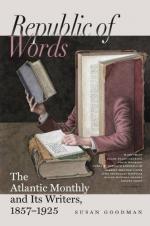Another lesson gave the vowels, (or voice-letters, as she called them,) and it was made lively by her writing afterwards all of them in one word, mieaou, and calling it the cat’s song. It took from a week to ten days to teach these letters, one lesson a day of about twenty minutes. Then came words: mamma, papa, puss, pussy, etc. The vowels were always sounded as in Italian, and i and y distinguished as with the dot and with a tail. At first only one word was the lesson, and the letters were reviewed in their divisions of lip-letters, throat-letters, tooth-letters, voice-letters. The latter were sounded the Italian way, as in the words arm, egg, ink, oak, and Per_u_. This teacher had Miss Peabody’s “First Nursery Reading-Book,” and when she had taught the class to make all the words on the first page of it, she gave each of the children the book and told them to find first one word and then another. It was a great pleasure to them to be told that now they could read. They were encouraged to copy the words out of the book upon their slates.
The “First Nursery Reading-Book” has in it no words that have exceptions in their spelling to the sounds given to the children as the powers of the letters. Nor has it any diphthong or combinations of letters, such as oi, ou, ch, sh, th. After they could read it at sight, they were told that all words were not so regular, and their attention was called to the initial sounds of thin, shin, and chin, and to the proper diphthongs, ou, oi, and au, and they wrote words considering these as additional characters. Then “Mother Goose” was put into their hands, and they were made to read by rote the songs they already knew by heart, and to copy them. It was a great entertainment to find the queer words, and these were made the nucleus of groups of similar words which were written on the blackboard and copied on their slates.
We have thought it worth while to give in detail this method of teaching to read, because it is the most entertaining to children to be taught so, and because many successful instances of the pursual of this plan have come under our observation; and one advantage of it has been, that the children so taught, though never going through the common spelling-lessons, have uniformly exhibited a rare exactness in orthography.
In going through this process, the children learn to print very nicely, and generally can do so sooner than they can read. It is a small matter afterwards to teach them to turn the print into script. They should be taught to write with the lead pencil before the pen, whose use need not come into the Kindergarten.




